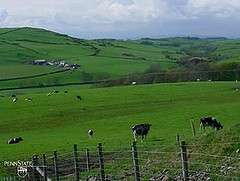Radioactive material gets into milk when it drops from the atmosphere onto grasses, which are then eaten by cows.
Radiation spewing from Japan's severely damaged nuclear facilities following the recent earthquake and tsunami is not endangering the United States' food supply, according to a food-safety expert in Penn State's College of Agricultural sciences.
Based upon the government reports, there is currently no risk to our country's food supply, said Martin Bucknavage, extension food-safety specialist. This includes fallout here in the United States from radiation released into the atmosphere in Japan and foods imported from areas with the potential for higher exposure.
"The U.S. Environmental Protection Agency has detected miniscule amounts of radiation in milk that can be attributed to the Japanese disaster, but these were so small that they pose no threat to human health," he said. "The levels found were 5,000 times lower than the level set by the Food and Drug Administration as posing a risk.
"Considering that -- and the fact that the radiation has a half-life of eight days -- there are currently no reasons to avoid drinking milk."
Radioactive material gets into milk when it drops from the atmosphere onto grasses, which are then eaten by cows, Bucknavage explained. In response to the nuclear disaster in Japan, the EPA and FDA have increased the level of monitoring of food, drinking water and rainwater.
"There have been a number of monitoring stations throughout the United State that have detected some minute levels of radiation, but this was expected," he said. "The levels seen must be put in perspective.
"According to the EPA, drinking water samples from two western locations -- Boise, Idaho, and Richland, Wash. -- showed trace amounts of iodine-131 that were approximately 0.2 picocuries per liter in each case," Bucknavage added.
"Even an infant would have to drink almost 7,000 liters of this water to receive a radiation dose equivalent to a day's worth of the natural background radiation exposure we experience continuously from natural sources of radioactivity in our environment."
The FDA has reported that no food is being exported from the affected area, and the agency is monitoring imported products from other areas of Japan. There has not been any radiation detected so far, Bucknavage noted.
The United States imports very little food from Japan, anyway, he pointed out. "Japan accounts for only about 4 percent of the food imported into the U.S."
"There have been specific concerns about seafood with higher levels of radioactive materials making its way into the United States," he said. "So in addition to blocking seafood from the affected areas, the FDA has increased its monitoring of all seafood coming into the United States. As of April 19, the FDA had not detected radionuclides from the reactors in any of the seafood samples tested."
Provided by Pennsylvania State University




















